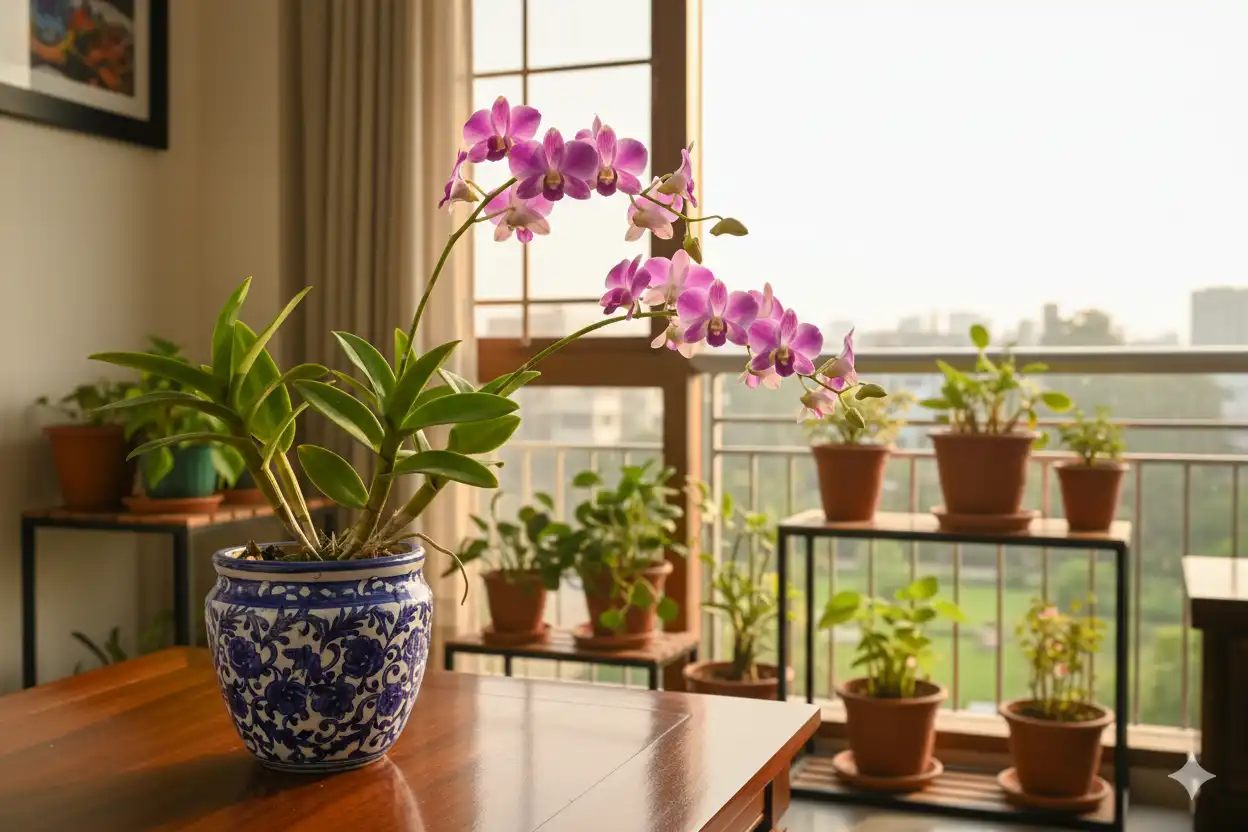
Dendrobium orchids can transform your home into a tropical paradise, but growing these stunning flowers in India’s unique climate requires specific knowledge and techniques. This comprehensive guide is designed for Indian orchid enthusiasts, beginners, and experienced gardeners who want to master dendrobium orchid care in our diverse weather conditions.
You’ll discover how to create the perfect growing environment that works with India’s humidity and temperature swings, plus learn the essential watering techniques that account for our monsoon seasons and dry spells. We’ll also cover the best growing mediums available in Indian markets and share fertilizing strategies that match our local growing conditions.
Your dendrobium phalaenopsis orchid care journey starts here, with practical advice that considers everything from apartment balconies in Mumbai to rooftop gardens in Delhi. Get ready to grow healthy, blooming orchids that thrive in the Indian climate year-round.
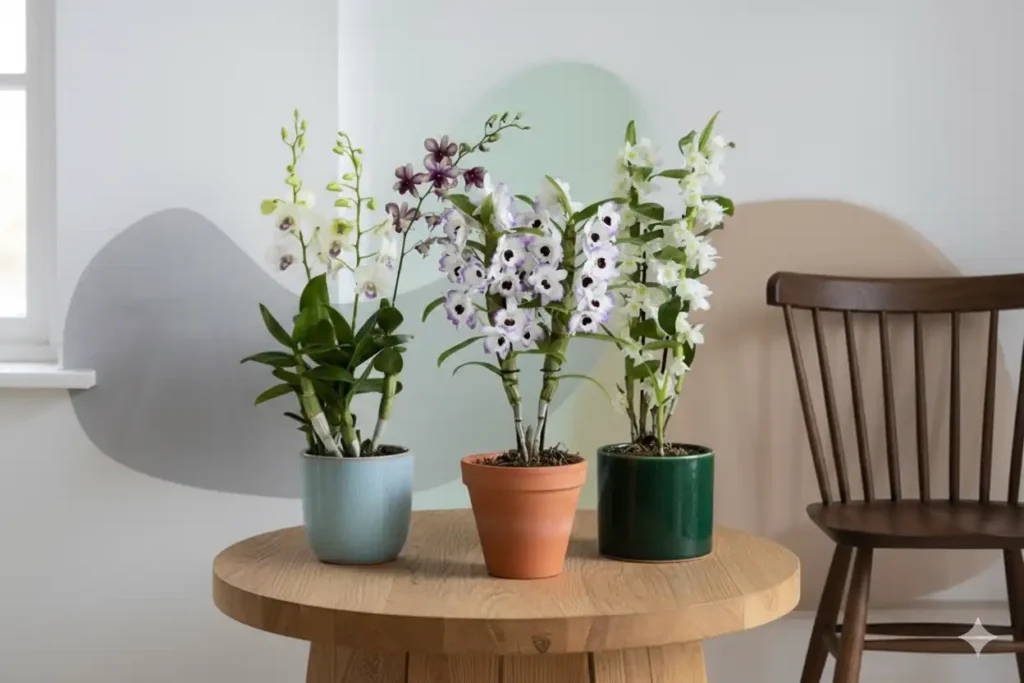
You’ll find remarkable success with Dendrobium Nobile and Dendrobium Phalaenopsis orchid in India’s diverse climate zones. These hardy varieties adapt brilliantly to your monsoon patterns and temperature fluctuations, making dendrobium hybrid orchid care surprisingly manageable for beginners and experts alike.
Your dendrobium orchid care routine becomes effortless once you understand their natural love for humidity and bright, filtered light. These resilient orchids handle temperature swings between 15-35°C perfectly, matching your regional weather patterns while requiring minimal intervention to flourish throughout the year.
| Variety Type | Best For | Growing Method |
|---|---|---|
| Dendrobium Phalaenopsis | Humid coastal areas like Mumbai, Chennai | Mounted on bark, hanging baskets, or pots with bark/coconut chip mix |
| Dendrobium Nobile | Cooler, subtropical regions in North-East India | Pots with bark/coconut chip mix, bright filtered light |
In India, almost all Dendrobiums available for sale are epiphytic, meaning they naturally grow on trees or rocks. These orchids thrive in different regional climates when grown in suitable conditions.
Note: True terrestrial Dendrobiums are rare and generally not available in Indian nurseries, so focusing on epiphytic types ensures the best chances for successful cultivation.
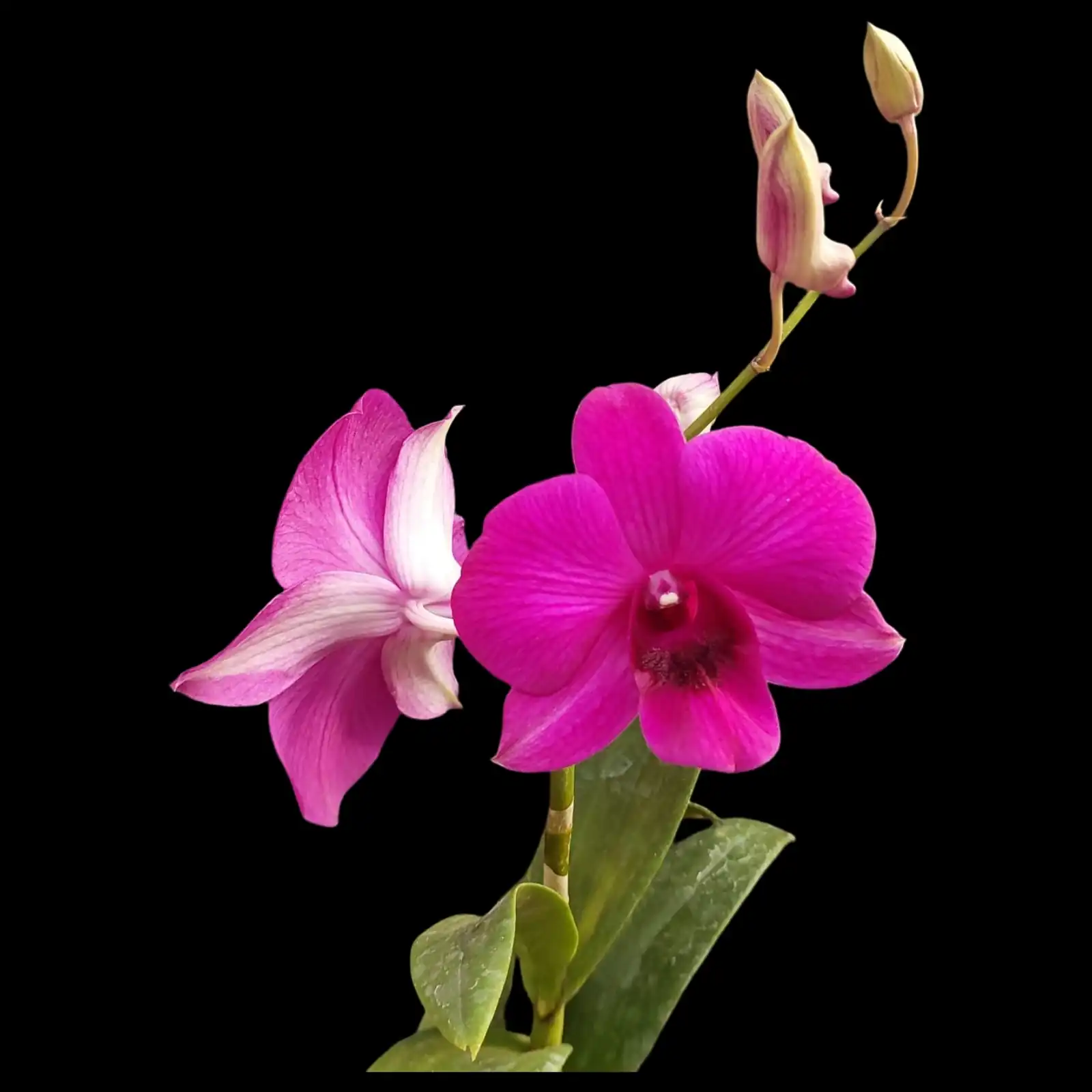
Dendrobium orchids are elegant, long-lasting plants that can brighten both indoor spaces and outdoor gardens. Whether you’re nurturing them inside your home or growing them outdoors in tropical regions like Kerala, Karnataka, or coastal India, proper care is key to healthy growth and vibrant blooms. Focus on light, humidity, air circulation, temperature, and seasonal adjustments for the best results.
Position your Dendrobium orchids near east- or south-facing windows, where they receive bright, filtered light for 6–8 hours daily. Avoid direct afternoon sun, which can scorch leaves during intense Indian summers. If natural light is insufficient, supplement with LED grow lights placed 12–18 inches above the plants to maintain proper photosynthesis.
Maintain 50–70% humidity year-round. During monsoons, use fans and ensure good ventilation to prevent fungal issues from excessive moisture. In dry winters, place humidity trays filled with water and pebbles beneath your orchids or group plants together to create a supportive microclimate.
Create gentle airflow around your orchids by placing them near open windows or using oscillating fans on low speed, at least 3 feet away. Proper air movement prevents root rot, fungal problems, and strengthens stems. Avoid placing orchids directly in air conditioning vents or strong drafts.
Maintain daytime temperatures between 20–35°C and nighttime temperatures 5–20°C cooler to trigger natural flowering cycles. During extreme summers, move plants to cooler indoor spots and increase humidity. In winter, protect from temperatures below 15°C by relocating plants away from cold windows and maintaining consistent warmth.
In humid, tropical regions like Kerala, coastal Karnataka, or coastal Tamil Nadu, Dendrobiums can thrive outdoors with careful attention to light, moisture, and seasonal changes.
Place orchids in partially shaded areas, such as under trees, verandas, or shaded garden corners. They need 4–6 hours of bright, filtered sunlight daily, while avoiding harsh afternoon sun that can burn leaves.
Monsoons can be challenging. Ensure excellent drainage and avoid waterlogging to prevent root rot. Use raised beds, hanging baskets, or slatted wooden mounts to let water drain freely.
Tropical outdoor conditions naturally provide 50–80% humidity, but good air circulation is essential. Avoid overcrowding plants and ensure gentle airflow to reduce the risk of fungal infections.
Outdoor Dendrobiums prefer 20–35°C during the day with slightly cooler nights. Protect plants if temperatures drop below 15°C in winter, using temporary shade or covers as needed.
Grow Dendrobiums in pots, hanging baskets, or mounted on trees. Epiphytic orchids thrive when attached to tree bark, mimicking their natural habitat and promoting healthy root development.
By following these indoor and outdoor Dendrobium orchid care strategies, your Dendrobium orchids will flourish across Indian climates—offering lush green foliage and stunning blooms throughout the year.
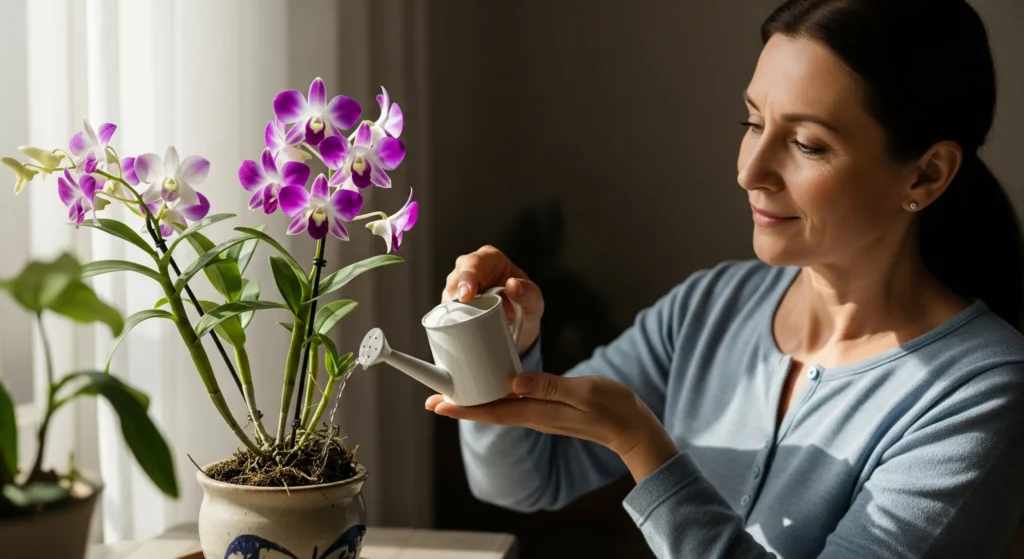
Watering is a key part of dendrobium orchid care, but it needs to change with the seasons. On normal days, water once or twice a week, allowing the medium to dry slightly between waterings. During winter, reduce watering to once every 10–14 days, as cooler temperatures slow growth and excess moisture can harm the roots.
During India’s intense monsoon months, your dendrobium orchid care routine needs a major shift. Cut back watering to once weekly or even less, since the high humidity keeps your orchids naturally hydrated. Monitor your growing medium closely – it should barely dry out between waterings during this period.
Your dendrobium phalaenopsis orchid care becomes much easier when you work with nature’s schedule. The constant moisture in the air means your plants absorb water through their aerial roots, reducing their dependence on traditional watering methods.
Overwatered dendrobium orchids show yellowing leaves starting from the bottom, soft pseudobulbs, and a musty smell around the roots. You’ll also notice new growth appearing pale and weak, with leaves dropping unexpectedly.
Underwatering creates wrinkled pseudobulbs, dry aerial roots that appear silvery-white, and leaves that feel leathery to touch. Your orchid’s growth slows dramatically, and flower buds may drop before opening. Balance comes from observing these signals and adjusting your watering schedule accordingly.
Water quality is just as important as watering frequency. In many parts of India, tap water contains salts, chlorine, or hardness that can damage orchid roots over time. A few simple adjustments can make a big difference:
RO Water: If available, this is the most reliable option since it is soft and free from harmful salts.
Stored Tap Water: Fill a container with tap water and leave it overnight. By the next day, chlorine will have evaporated, making it gentler on roots.
Filtered Water: Even a basic kitchen filter helps reduce impurities compared to direct tap water.
Rainwater: Collect during clean rainfall and store in a covered container. Naturally soft and orchid-friendly.
Avoid Softened Water: Do not use water from domestic softeners, as it contains sodium, which can burn orchid roots and block nutrient absorption.
💡 Tip: Consistently using soft, clean water prevents salt buildup, ensures better nutrient absorption, and keeps roots healthy for long-term growth.
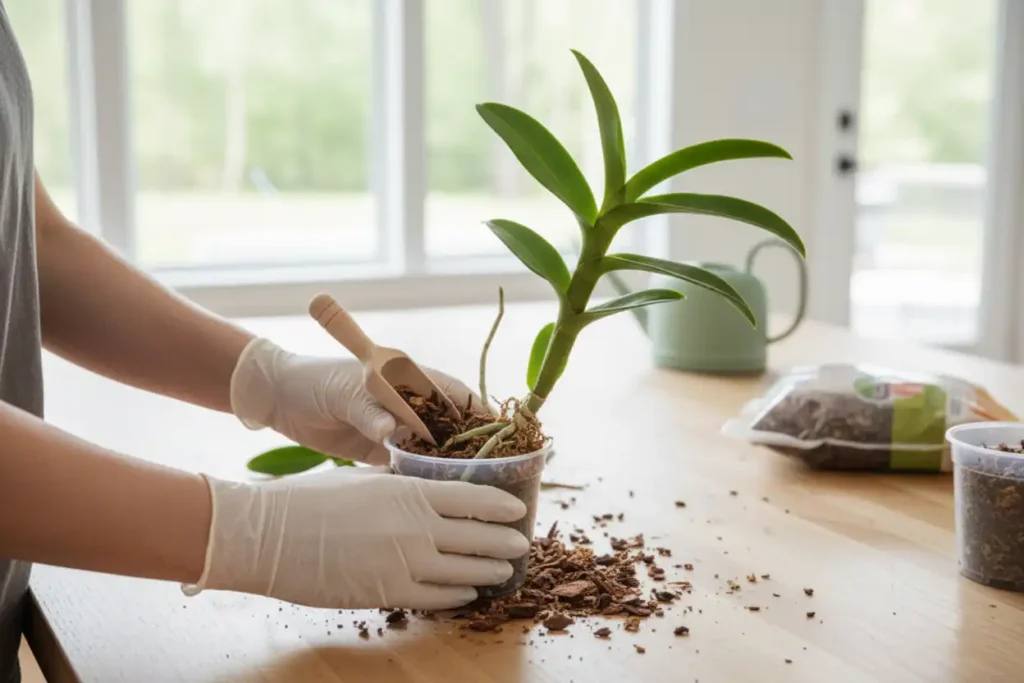
Your local nurseries and garden centers typically stock orchid bark, coconut husk chips, charcoal and sphagnum moss. Check with suppliers in major cities like Delhi, Mumbai, or Bangalore for premium materials. You can also source coconut coir and tree fern fiber from regional distributors. Online platforms offer convenient access to specialized orchid growing mediums when local options are limited.
Mix charcoal with coconut husk chips in a 60:40 ratio for excellent drainage. Add perlite or stones to improve aeration around your dendrobium’s roots. Include small amounts of sphagnum moss to retain moisture without waterlogging. This combination supports proper dendrobium orchid care by preventing root rot while maintaining adequate humidity levels.
Steam your potting materials for 20-30 minutes before use to eliminate harmful bacteria and fungi. You can also soak bark, coconut husk and moss in Pseudomonas fluorescens for effective sterilization. Allow all components to dry completely before mixing. This step is crucial for dendrobium hybrid orchid care success, especially during India’s humid monsoon season.
Repot your dendrobiums every 18–24 months, or earlier if the potting mix begins to break down. Opt for clear plastic pots with plenty of drainage holes to easily monitor root health. Gently remove old bark from the roots and trim any damaged sections with sterilized scissors. Refreshing the medium ensures strong growth and aligns with essential Dendrobium Phalaenopsis orchid care practices.
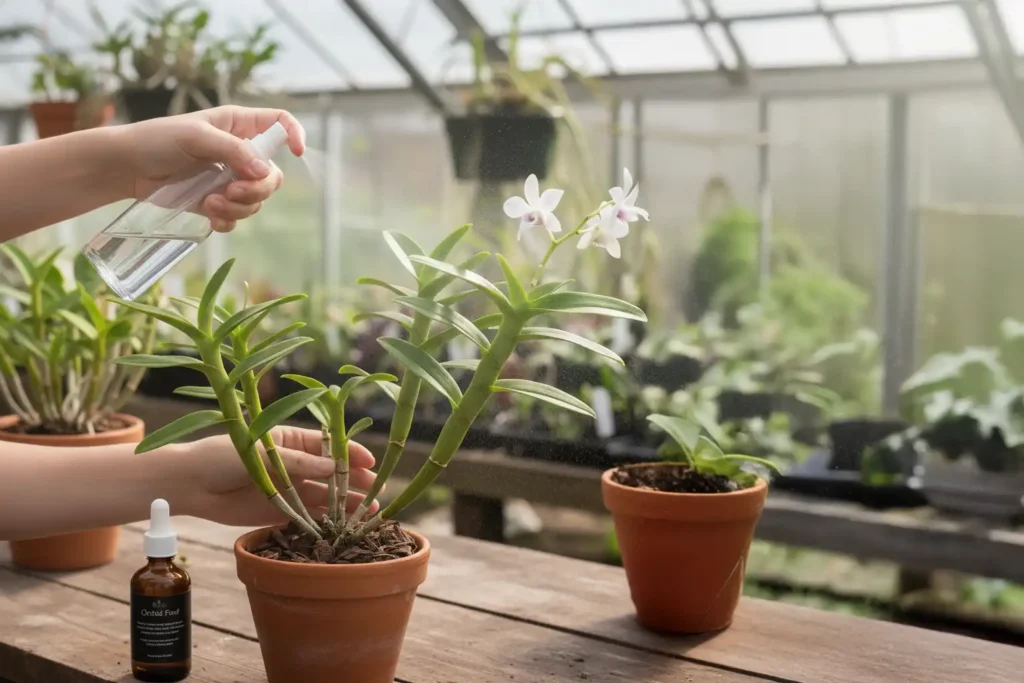
Your local garden centers stock several fertilizer options perfect for dendrobium orchid care. Look for balanced NPK fertilizers like 19-19-19 or orchid-specific blends from brands like Stearling Group. Water-soluble fertilizers work best since they dissolve quickly and prevent salt buildup in your growing medium. You can also find specialized orchid fertilizers that contain micronutrients essential for healthy growth. These products are specifically formulated for epiphytic plants and provide the gentle feeding your dendrobiums need without burning their delicate roots.
For mature plants, use 19:19:19 at 2 grams per liter twice a week. To induce flowering, apply fertilizers such as 13:27:27, 13:40:13, or Orchid Boon 8:25:25 at 2 grams per liter once a week. Seedlings or unhealthy plants benefit from a high-nitrogen fertilizer like 30:10:10 or Orchid Boon 25:10:15, also at 2 grams per liter once a week, along with essential micronutrients. Additionally, magnesium sulphate and calcium nitrate can be applied every two weeks to support healthy growth.
Adjusting your feeding schedule according to the seasons helps your orchids thrive. During the monsoon, reduce fertilizing to once every two weeks, using about half the recommended strength, as high humidity slows nutrient uptake and plant activity. In dry seasons and active growth periods, feed your orchids weekly when temperatures are moderate and growth is vigorous. Always fertilize after watering to protect delicate roots from damage.
Alongside regular chemical fertilizers, certain organic supplements can enhance plant health, improve root development, and boost flowering:
Seaweed Extracts / Kelp Fertilizers: Rich in trace elements and natural growth hormones, they strengthen roots and improve stress tolerance. Use as a foliar spray or soil drench every 2–3 weeks.
Vermicompost Extract (Worm Tea): Provides beneficial microbes and nutrients in small amounts, helping seedlings and stressed plants recover. Apply once a week at a diluted concentration.
Fish Emulsion: Supplies phosphorus and micronutrients, aiding root growth and flower induction. Use sparingly, once every 2–4 weeks.
Coconut Water: Contains natural growth-promoting compounds and potassium, ideal for supplementing young or weak plants. Dilute before use and apply occasionally.
These supplements should be used in addition to your regular NPK or flowering fertilizers, providing a gentle boost without overloading the plant.